2010 Kawasaki Jet Ski Ultra 260LX Review
Sometime during lunch the wind changed. Too bad, because our morning cruise south along the San Diego coastline had been near picture-perfect. But now, those once-glassy Pacific swells are windswept, choppy ones, guaranteed to test the mettle of any personal watercraft.
In other words, it’s a great day to be aboard a Kawasaki Ultra 260LX.
Let’s Cruise
Ever since their introduction, the Ultras have gained a reputation as big-water favorites. The 260LX is big (11’ in LOA), heavy (1063 pounds), and features a deep-V hull that tracks straight, behaves predictably, and softens the blow of big-water chop. Splash-deflecting ridges also keep the bow spray to a minimum, a big bonus in rough water. Endurance racers have made it a favorite, and the craft has delivered in return, routinely chalking up wins in offshore endurance races.
No, I didn’t sit in comfort on that ride back up the San Diego coast. I stood and hung on, like you’d expect. But along the way the Ultra never gave me a surprise shift in direction, never a teeth-rattling jolt. Instead I was able to handle big water like those racers, confident, stable, and in control. That’s what Ultras do best.
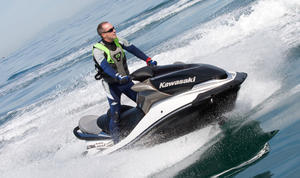 For 2010 the Ultra 260LX comes in a more subdued black/white metallic color scheme.
For 2010 the Ultra 260LX comes in a more subdued black/white metallic color scheme.Of course, what the LX does best is throw a little more comfort your way than the 260X, and I could truly appreciate those features while cruising the lengthy, calmer passages of San Diego Bay. Along with a more upscale, less flashy paint job (think more metallic, less flashy graphics), the LX also gives you a touring seat, a bolstered, cushiony perch that does wonders for the lower back and substantially boosts comfort on long-distance rides. I like Kawasaki’s seat because it’s not as fixed and rigid in its padding as some of the competition. Load up with three passengers and if someone doesn’t fit the mold, they’re not riding atop that hump like a third child straddling the hump in the back seat of a 1970s Pinto. Instead, the seat compresses enough to get out of the way.
Further dialing things in for the driver is a five-position handlebar. It pivots to match a rider’s preference, sitting or standing. I only wish Kawasaki could do something about their instrumentation. It continues to be small, and hard to see once those bars pivot up. The two function buttons, located under the display, are also quite difficult to access. I don’t see the situation changing, however, so it’s a shortcoming you’ll have to tolerate.
The Beast
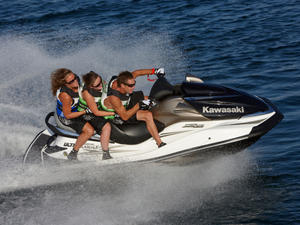 As always, the best thing about this craft is its awesome 260 horsepower engine.
As always, the best thing about this craft is its awesome 260 horsepower engine.And one of the things that makes that shortcoming, and any others, all the more tolerable is the beast of an engine within.
Like the Ultra 260X, the LX features a monster of an engine, a 260hp, 1,498cc, dual overhead cam, four-cylinder mill boosted by a Roots-style supercharger and large intercooler. In decent conditions, it reaches the high 60s with relative ease, and with a light load should reach the 68mph mark. Yet for all its substantial girth, acceleration times from 0-30mph fall below the two-second mark.
In short, it’s a powerful machine, even within the guise of luxury.
The Ultra 260LX is also a beast of a touring machine. Consider capacity. The LX holds over 20 gallons of fuel, meaning you can cruise for extended periods between fuel stops. (That’s assuming you don’t pin that powerful engine the whole way — if so, then all bets are off.) You can also carry plenty of gear along on the ride. Ultras feature simply massive storage capacities, with 53 gallons split between the deep front tub and slip-in bucket, a nice glove box, and small nook below the split-seat that’s great for dock lines.
Want more? Everybody does at this end of the spectrum. Kawasaki further obliges with a flip-down boarding step for deepwater boarding, along with a plug-in key for theft prevention. A second key will limit RPM for those times when you invite someone new to try the boat out.
Back in San Diego…
Back in the seat of my San Diego excursion, kelp beds have pushed us further offshore, and we’re doing battle against the elements trying to make it home.
But as any offshore aficionado would agree, I’m in good hands. Or at least, on the right watercraft…
| Kawasaki Jet Ski Ultra 260LX Specs | |
| Length | 132.7 inches |
| Beam | 46.9 inches |
| Curb Weight | 1,062.8 lbs |
| Engine | Four-cylinder DOHC EFI; Supercharged/Intercooled |
| Displacement | 1,498 cc |
| Bore and Stroke | 83mm x 69.2mm |
| Compression Ratio | 8.4:1 |
| Rated Horsepower | 260 |
| Fuel Capacity | 20.6 gal. |
| Combined Stowage Capacity | 53 gal. |
| Colors | Jet Black/Pearl White |
| Price | $13,199 |
Related Reading
2010 Kawasaki Jet Ski Ultra 260X Review
2010 Kawasaki Jet Ski STX-15F Review
All Things Kawasaki on PersonalWatercraft.com
Get PersonalWatercraft.com in your Inbox!
Like PersonalWatercraft.com on Facebook
Comments
Most Popular

Remembering the Sea-Doo XP

2025 Yamaha JetBlaster PRO 2-Up Review

2024 Yamaha GP HO Review

2008 Kawasaki Jet Ski Ultra 250X Review

2024 Kawasaki Jet Ski STX 160X Review




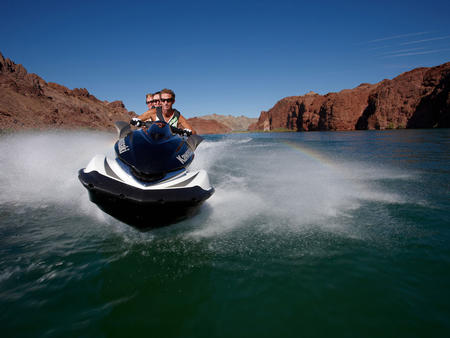
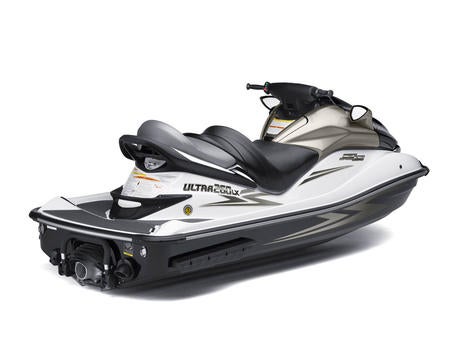
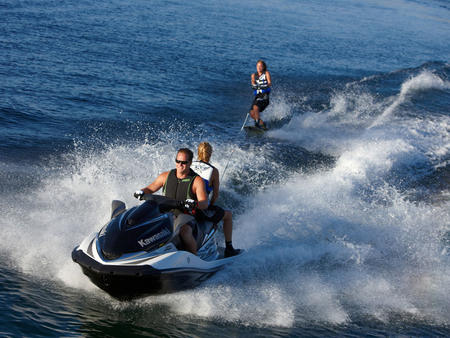








 Your Privacy Choices
Your Privacy Choices